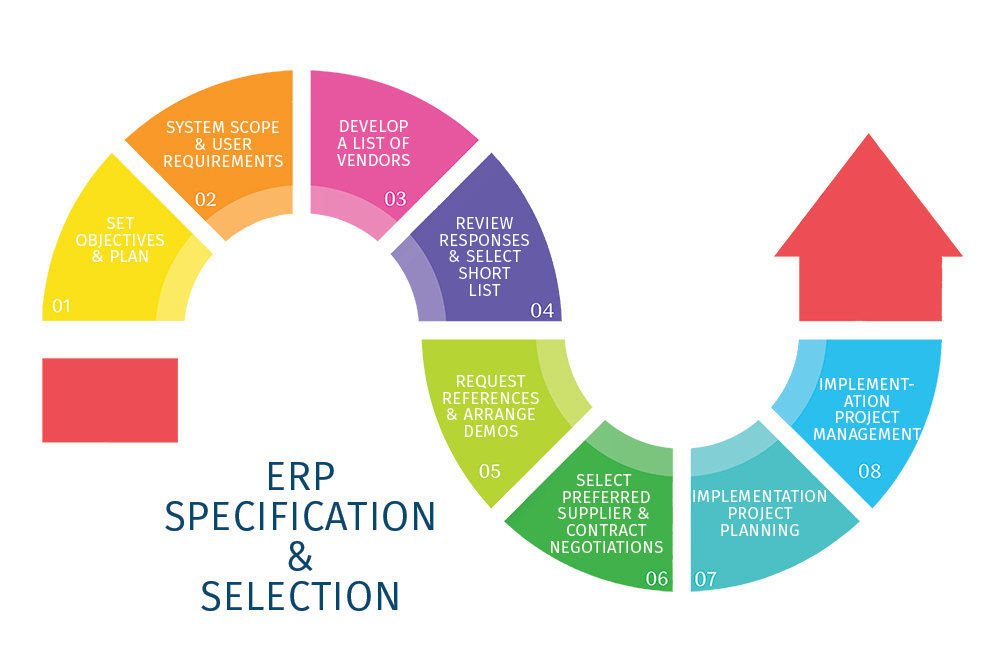ERP System Specification & Selection

Enterprise software specialist, Barry Linnard, has been providing ERP consultation services to the manufacturing industry for over 30 years. Recently we’ve been working on an ERP specification and selection project with him and were impressed by his depth of knowledge, experience and processes for helping companies find the right system. We asked Barry if he would be prepared to share some details of the process he’s created to help manufacturers develop a specification and select the best system solution. This blog includes many of Barry’s ideas and recommendations, with more details available on our website.
“One of the first things I realised early in my career is that people buy people. It’s very easy when sitting through several demonstrations of similar systems to connect more with sales representatives or BDMs. To counteract this behaviour, I’ve laid out a process that focuses solidly on the quantitative aspects of identifying, assessing and implementing the correct system.
Stage 1 – Set Objectives & Plan
There’s a significant amount of groundwork that needs to be done before companies even enter the ERP market. Objectives need to be set and the project needs to be planned – after all, ERP system specification and selection is often a project that is done on top of the key individuals’ day to day roles so tasks need to be allocated and time allowed to do these to keep a project on track.
Companies then need to look at where they are now and where they want to be. Consider processes, resources, costs – what improvements do you want to make across these? Only once a clear plan of what needs to be achieved is formulated can companies move to the next stage.
Stage 2 – System Scope & User Requirements
Scoping a system correctly is vital to the success of the project. Consider the objectives you set in stage one and determine what functionality you need in a system to achieve these. Try to lay out everything you need at this stage as ‘scope creep’ is often the cause of project delay and overspend. Once this is documented – and there is a lot to think through here – obtain agreement from the key personnel who will be using the system and have them sign off on this. You are now ready to go to market.
Stage 3 – Develop a List of Potential Vendors
Time is precious and viewing multiple demonstrations of similar software is not conducive to an effective project. Doing the groundwork properly now to identify vendors who can meet your requirements (as laid out in stage 2) will save you much time in the long run. You can start with a longer list of vendors and narrow it down to those appropriate. It is critical that you understand the nuances between enterprise systems to avoid wasted time and delay – often it is worth working with someone who knows this market and products well to help identify a few solutions that meet your needs. When confident you have identified appropriate vendors, an Invitation to Tender can be issued.
Stage 4 – Review and Select Short List of Vendors
In my experience, software providers will usually respond positively and convincingly that their product will meet your every need. No system is perfect! Look out for generalisations in their response, standard stock responses or sales documents to help you identify who can genuinely meet your requirements.
Stage 5 – Request Vendor References & Arrange Demonstrations
Now we’re getting to the pointy end of the process and it’s time to obtain proof from vendors that they are able to meet your functionality requirements. I recommend asking for details of their customers that are similar to your business and have been delivered similar solutions to that you are seeking. By sending those customers a detailed questionnaire that covers all areas of interest, you can gather more information across all aspects of the system than you may be able to do with one or two reference site visits.
System demonstrations are probably the most critical element of the ERP system selection process. To get the most out of these, don’t allow the vendor to run the demonstration. Whilst you’ll see every feature in their software, this makes each demo extremely time consuming. Instead, provide in advance a ‘script’ for vendors to follow throughout their demonstration. This script should be based on your functionality requirements and provides the vendor with the opportunity to prove they understand your needs and can deliver the functionality you need. By providing each vendor with the same script, the subsequent like-for-like demonstrations are much easier to compare and use as a basis, in conjunction with the ITT and references, to make a decision on the preferred supplier.
Stage 6 – Contract Negotiations
Contracts for the supply of software and services can vary greatly from other commercial contracts in many ways. Key areas to consider include how best you can secure protection for your business, especially during delivery and implementation (which can be a tricky time), how you can obtain the highest ongoing service levels from your chosen vendor and what future costs you may be liable for.
Stage 7 – Implementation Project Planning
Implementing a new ERP system is never easy but thorough advance planning, in conjunction with your selected vendor, will identify potential risks and help minimises any surprises which may derail the process.
Stage 8 – Implementation Project Management
You’re almost there! Implementation is the final stage of the ERP system specification and selection process and will have its challenges but these can be minimised if both you and the vendor allocate the appropriate time and resource to the project. Most vendors will appoint their own project manager and I highly recommend the business implementing the ERP system do the same. Trying to implement a system on top of your day to day duties can become overwhelming and lead to delays and cost overruns. The best scenario is to appoint your own dedicated internal project manager but if this is not possible, bringing in an experienced external consultant to manage the process and keep the vendor, your business and the plan on track is also a good option.”
If you would like more information on Barry’s process for specifying and selecting an ERP system, please contact Barry. If you are interested in finding an ERP system for your business, you can find more information on what E-Max ERP offers by speaking to one of our team, contacting us or on our website here. Of course, if you’re ready for a demonstration of E-Max ERP in action, then you can arrange a demo at a time convenient to you.

